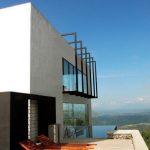-
A Home Of Contemporary Nostalgia
January 2011
Archt. Prasanna Jayalath has ventured to create living spaces that reflected the charms of the olden day manor house intermingling with congruent nuances of the contemporary in his design for the Pathiraja House. The house sits at a high elevation on the Kegalle-Polgahawela road. It’s located in a serene locality facing a temple directly across the way.
By: Prasadini Nanayakkara | Photography by: Sanjaya Vithana


The house, a single-storey block is dominated by a tall vertical structure at its entrance. Its stark white exterior is mellowed by the shade of the trees in the vicinity. At a glance the house conveys a contemporary linear minimalism. The vehicular access leads to the front and the pedestrian access to the rear of the house. A short flight of steps flanked by rubble retainers leads to a brick paving at the entrance where the double pivot wooden door

devoid of hinges, inspired by ancient temple architecture gives access to the interior of the house.
The house is built around a courtyard – a characteristic of old manor houses and comprises of a black tiled reflective pond with a temple tree – the centerpiece for the house. Entering through a lobby area, the living and dining spaces border the courtyard pond from the front and the rear respectively. Each are provided visual access through timber framed glass sliding doors. A sense of continuity prevails as the water level of the pond is on par with the floors bordering it.
The five bedrooms including the master bedroom, are provided with a view of its immediate surroundings while the room adjacent to the lobby opens out to a private garden. The open air bathrooms contribute to maintain the airy atmosphere in all parts of the house. Along the left boundary, is a corridor leading to the rear verandah and the bedrooms, with views of the courtyard through interspersing spaces. Ample air-circulation afforded by the courtyard and open free flowing spaces, cross ventilation is further enhanced by wall perforations for the lobby and the adjacent bedroom. The open verandah at the rear of the house overlooks trimmed lawns and a brick paved area. Adjacently lies the two car park garage and the rear of the house also accommodates service areas including the kitchen and servants quarters. A third entrance to the house is through two doorways that open to a corridor leading to the dining area.
 The simplistic impressions of a Walawwa is accentuated by polished cut cement floors for all the living spaces of the house and coupled with the gabled roofs with timber ceilings, imparting a warm and cozy atmosphere. The exposed timber rafters for the ceiling and the timber windows of the bedrooms inspired by Dutch colonial architecture are more features of throwbacks to the olden day.
The simplistic impressions of a Walawwa is accentuated by polished cut cement floors for all the living spaces of the house and coupled with the gabled roofs with timber ceilings, imparting a warm and cozy atmosphere. The exposed timber rafters for the ceiling and the timber windows of the bedrooms inspired by Dutch colonial architecture are more features of throwbacks to the olden day.

The gabled roofs sheltering the three distinct spaces, the living, dining and bedroom wings, are covered half round tiles and are interconnected by roof slabs.
“Keeping the client’s requirements in mind I have used several elements of an old walawwa house to create a modern interpretation,”
says the Architect.
Many of the interior furniture and fittings are of contemporary designs that complement the antique pieces inherited from the manor house. Through the Dutch colonial architecture and its seamless merger with olden day manor house influences, the Architect has not only attempted to kindle nostalgia for its occupants but also to direct attention to a cultural landmark in the vicinity.
Architect Jayalath appreciates the support given by the client. “It was easy for me to bring this about as the client gave me the freedom to do so,” he said.

“Keeping the client’s requirements in mind I have used several elements of an old walawwa house to create a modern interpretation,” the Architect concluded.
Principal Architect: Prasanna Jayalath
Other consultants:
Design Team: Nayana Jayasekara | Wajeeshani Gamage
Structural Engineer: Wasantha Chandrathilake
Client: Mr & Mrs Pathiraja
Total Area: 5990 sq ft
Date of Completion: April 2006











